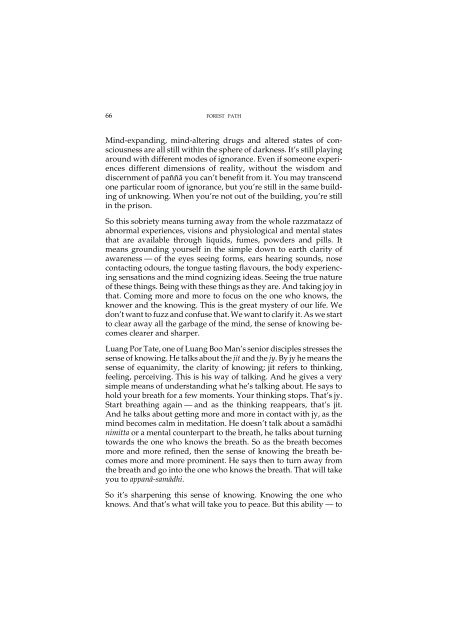Forest Path - Amaravati Buddhist Monastery
Forest Path - Amaravati Buddhist Monastery
Forest Path - Amaravati Buddhist Monastery
Create successful ePaper yourself
Turn your PDF publications into a flip-book with our unique Google optimized e-Paper software.
66 forest path<br />
Mind-expanding, mind-altering drugs and altered states of consciousness<br />
are all still within the sphere of darkness. It’s still playing<br />
around with different modes of ignorance. Even if someone experiences<br />
different dimensions of reality, without the wisdom and<br />
discernment of pa¤¤à you can’t benefit from it. You may transcend<br />
one particular room of ignorance, but you’re still in the same building<br />
of unknowing. When you’re not out of the building, you’re still<br />
in the prison.<br />
So this sobriety means turning away from the whole razzmatazz of<br />
abnormal experiences, visions and physiological and mental states<br />
that are available through liquids, fumes, powders and pills. It<br />
means grounding yourself in the simple down to earth clarity of<br />
awareness — of the eyes seeing forms, ears hearing sounds, nose<br />
contacting odours, the tongue tasting flavours, the body experiencing<br />
sensations and the mind cognizing ideas. Seeing the true nature<br />
of these things. Being with these things as they are. And taking joy in<br />
that. Coming more and more to focus on the one who knows, the<br />
knower and the knowing. This is the great mystery of our life. We<br />
don’t want to fuzz and confuse that. We want to clarify it. As we start<br />
to clear away all the garbage of the mind, the sense of knowing becomes<br />
clearer and sharper.<br />
Luang Por Tate, one of Luang Boo Man’s senior disciples stresses the<br />
sense of knowing. He talks about the jit and the jy. By jy he means the<br />
sense of equanimity, the clarity of knowing; jit refers to thinking,<br />
feeling, perceiving. This is his way of talking. And he gives a very<br />
simple means of understanding what he’s talking about. He says to<br />
hold your breath for a few moments. Your thinking stops. That’s jy.<br />
Start breathing again — and as the thinking reappears, that’s jit.<br />
And he talks about getting more and more in contact with jy, as the<br />
mind becomes calm in meditation. He doesn’t talk about a samàdhi<br />
nimitta or a mental counterpart to the breath, he talks about turning<br />
towards the one who knows the breath. So as the breath becomes<br />
more and more refined, then the sense of knowing the breath becomes<br />
more and more prominent. He says then to turn away from<br />
the breath and go into the one who knows the breath. That will take<br />
you to appanà-samàdhi.<br />
So it’s sharpening this sense of knowing. Knowing the one who<br />
knows. And that’s what will take you to peace. But this ability — to

















